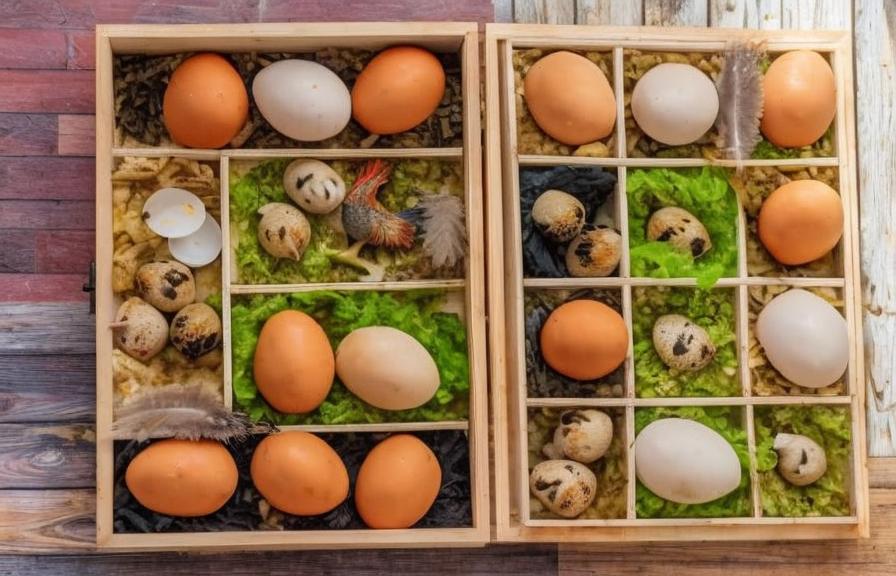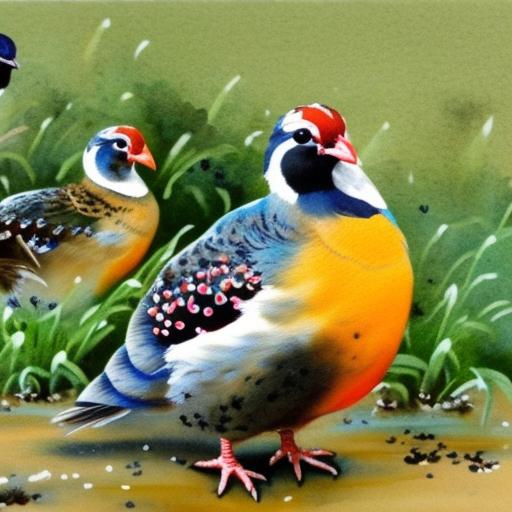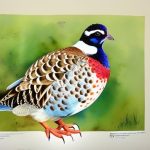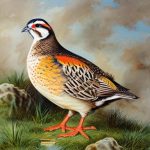Chinese Painted Quail, also known as King Quail or Button Quail, are small, colorful birds that are popular among aviculture enthusiasts for their beauty and relatively easy care. Breeding Chinese Painted Quail can be a rewarding hobby or a small-scale business venture. These quail are native to Southeast Asia and are known for their vibrant plumage and small size, making them an attractive addition to any aviary or backyard. Breeding Chinese Painted Quail requires careful attention to their specific needs, including selecting and pairing breeding stock, setting up a suitable breeding environment, egg incubation and hatching, caring for chicks and young quail, health and disease management, and selling and marketing the quail. This article will provide a comprehensive guide to breeding Chinese Painted Quail, covering all aspects of the process from start to finish.
Chinese Painted Quail are relatively easy to breed in captivity, making them an ideal choice for beginners in aviculture. They are also a popular choice for experienced breeders looking to add diversity to their collection. With the right knowledge and care, breeding Chinese Painted Quail can be a fulfilling and enjoyable experience. Whether you are interested in breeding these quail as a hobby or as a small business venture, understanding the intricacies of their breeding process is essential for success. From selecting breeding stock to caring for chicks and managing their health, this guide will provide you with all the information you need to start breeding Chinese Painted Quail successfully.
Key Takeaways
- Chinese Painted Quail breeding is a rewarding hobby that requires careful planning and attention to detail.
- Select breeding stock based on health, temperament, and desirable traits such as coloration and size.
- Create a suitable breeding environment with proper lighting, temperature, and nesting materials to encourage breeding behavior.
- Monitor egg incubation and provide a warm, clean environment for hatching and early chick care.
- Implement a health management plan to prevent and address common quail diseases, and consider selling surplus quail to interested buyers.
Selecting and Pairing Breeding Stock
Selecting the right breeding stock is crucial for successful Chinese Painted Quail breeding. When choosing breeding stock, it is important to select healthy, vibrant birds with good genetic traits. Look for birds that are active, alert, and free from any signs of illness or deformities. It is also important to consider the birds’ coloration and markings, as these traits will be passed on to their offspring. When selecting breeding stock, it is recommended to choose birds from different bloodlines to avoid inbreeding and maintain genetic diversity within the population.
Pairing the breeding stock is another important aspect of Chinese Painted Quail breeding. It is best to pair one male with two or three females to ensure successful mating and fertility. When pairing the birds, observe their behavior to ensure compatibility. Avoid pairing aggressive or overly dominant birds together, as this can lead to stress and conflict within the group. It is also important to monitor the birds closely after pairing to ensure that mating is occurring and that the females are laying eggs regularly. By carefully selecting and pairing breeding stock, you can lay the foundation for a successful Chinese Painted Quail breeding program.
Setting Up a Breeding Environment
Creating a suitable breeding environment is essential for the health and well-being of Chinese Painted Quail and the success of their breeding efforts. The breeding environment should mimic the quail’s natural habitat as closely as possible, providing them with the space, shelter, and resources they need to thrive. A spacious aviary with plenty of hiding spots, such as plants or shelters, is ideal for housing breeding quail. The aviary should also have a secure enclosure to protect the birds from predators and provide them with a safe and stress-free environment.
In addition to providing a secure and spacious aviary, it is important to create a suitable nesting area for the quail. This can be achieved by providing nesting boxes or shelters filled with soft bedding material, such as straw or shredded paper. The nesting area should be located in a quiet and secluded part of the aviary to provide the quail with privacy and security during the breeding process. It is also important to provide the quail with a balanced diet that includes high-quality quail feed, fresh water, and occasional treats such as mealworms or greens. By creating a suitable breeding environment with ample space, shelter, and resources, you can ensure the health and well-being of your Chinese Painted Quail and create an ideal setting for successful breeding.
Egg Incubation and Hatching
Once the breeding stock has been paired and settled into their breeding environment, the next step in the Chinese Painted Quail breeding process is egg incubation and hatching. Female quail will lay eggs regularly once they are in a suitable breeding environment, typically laying one egg every day or two. It is important to collect the eggs daily to prevent them from being damaged or eaten by the birds. Once collected, the eggs should be placed in an incubator set at the appropriate temperature and humidity for Chinese Painted Quail eggs.
Chinese Painted Quail eggs typically take around 17 days to hatch, but this can vary slightly depending on the specific conditions in the incubator. It is important to monitor the temperature and humidity levels in the incubator closely to ensure optimal conditions for egg development. Turning the eggs several times a day during the incubation period can also help prevent the embryos from sticking to the shell membrane and improve hatch rates. Once the eggs begin to hatch, it is important to provide the chicks with a warm and safe brooding area equipped with a heat source, such as a heat lamp or heating pad. By carefully managing the egg incubation and hatching process, you can maximize hatch rates and ensure the health and vitality of the newly hatched chicks.
Caring for Chicks and Young Quail
Caring for chicks and young quail requires careful attention to their specific needs to ensure their health and well-being. Newly hatched chicks are fragile and require a warm and secure brooding area equipped with a heat source to maintain their body temperature. It is important to provide them with access to fresh water and high-quality chick starter feed formulated specifically for young quail. Additionally, it is essential to monitor the chicks closely for any signs of illness or weakness and provide prompt care as needed.
As the chicks grow, they will require more space and access to a larger outdoor area where they can exercise and explore. It is important to gradually introduce them to their new environment to prevent stress or injury. Providing them with plenty of hiding spots, such as plants or shelters, can help reduce stress and promote natural behaviors. It is also important to continue providing them with a balanced diet that meets their nutritional needs as they grow. By providing attentive care and meeting their specific needs at each stage of development, you can ensure that your Chinese Painted Quail chicks grow into healthy and vibrant adults.
Health and Disease Management

Maintaining the health of your Chinese Painted Quail is essential for successful breeding and overall well-being of your birds. Regular health checks should be conducted to monitor for any signs of illness or injury. It is important to provide your quail with a clean and hygienic environment to prevent the spread of disease. This includes regularly cleaning their aviary, nesting areas, feeders, and waterers.
In addition to maintaining a clean environment, it is important to provide your quail with a balanced diet that meets their nutritional needs. High-quality quail feed should be supplemented with fresh water and occasional treats such as mealworms or greens. Providing your quail with access to natural sunlight can also help boost their immune system and overall health.
Despite your best efforts, it is still possible for your quail to become ill. It is important to be familiar with common quail diseases and their symptoms so that you can take prompt action if necessary. Working with an avian veterinarian who has experience with quail can be invaluable in maintaining your birds’ health.
Selling and Marketing Chinese Painted Quail
Once you have successfully bred Chinese Painted Quail, you may choose to sell them as pets or breeding stock. Before selling your quail, it is important to ensure that they are healthy, well-socialized, and ready for their new homes. Providing potential buyers with information about caring for Chinese Painted Quail can help ensure that they are prepared to provide proper care for their new birds.
When marketing your quail for sale, it is important to highlight their unique characteristics and appeal as pets or aviary birds. Utilizing online platforms such as social media or dedicated aviculture websites can help you reach potential buyers who are interested in adding Chinese Painted Quail to their collection.
In addition to selling live birds, you may also choose to sell hatching eggs or chicks to other aviculture enthusiasts who are interested in breeding their own quail. Providing accurate information about your breeding stock’s genetics, coloration, and health history can help attract buyers who are looking for specific traits in their quail.
In conclusion, breeding Chinese Painted Quail can be a rewarding endeavor for aviculture enthusiasts looking to add diversity to their collection or start a small-scale business venture. By carefully selecting and pairing breeding stock, creating a suitable breeding environment, managing egg incubation and hatching, caring for chicks and young quail, maintaining their health, and effectively marketing them for sale, you can successfully breed Chinese Painted Quail while ensuring their health and well-being throughout the process.
If you’re a Chinese painted quail breeder, you may also be interested in learning about the housing needs of other poultry. Poultry Wizard has a helpful article on whether turkeys need a coop, which can provide valuable insights into creating suitable living spaces for different types of birds. Check out the article here.
FAQs
What is a Chinese Painted Quail breeder?
A Chinese Painted Quail breeder is a person or business that specializes in breeding and raising Chinese Painted Quail, also known as King Quail, for sale to pet owners, bird enthusiasts, and other breeders.
What do Chinese Painted Quail breeders do?
Chinese Painted Quail breeders are responsible for selecting healthy breeding stock, providing proper housing and nutrition, incubating and hatching eggs, and caring for the young quail until they are ready to be sold or rehomed.
Where can I find a Chinese Painted Quail breeder?
Chinese Painted Quail breeders can be found through online classifieds, bird breeder directories, and at bird shows and expos. It’s important to research and choose a reputable breeder with a good track record of healthy, well-cared-for quail.
What should I look for in a Chinese Painted Quail breeder?
When looking for a Chinese Painted Quail breeder, it’s important to consider the breeder’s experience, the quality of their facilities, the health and condition of their quail, and their breeding practices. A good breeder will be transparent about their methods and willing to provide information and support to buyers.
Are there any regulations or standards for Chinese Painted Quail breeders?
Regulations and standards for Chinese Painted Quail breeders may vary by location. It’s important to research and understand any local or national laws or guidelines that apply to breeding and selling quail, and to ensure that the breeder you choose complies with these regulations.
Meet Walter, the feathered-friend fanatic of Florida! Nestled in the sunshine state, Walter struts through life with his feathered companions, clucking his way to happiness. With a coop that’s fancier than a five-star hotel, he’s the Don Juan of the chicken world. When he’s not teaching his hens to do the cha-cha, you’ll find him in a heated debate with his prized rooster, Sir Clucks-a-Lot. Walter’s poultry passion is no yolk; he’s the sunny-side-up guy you never knew you needed in your flock of friends!







